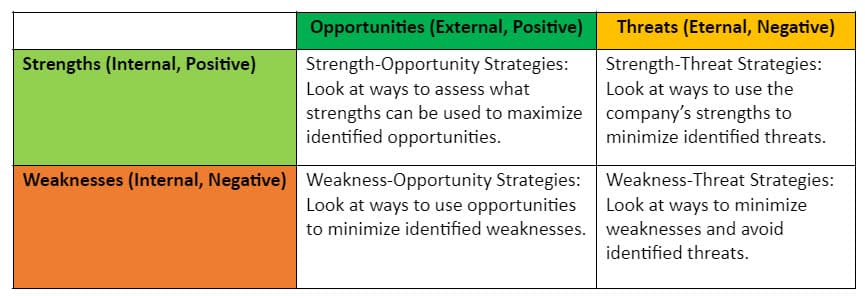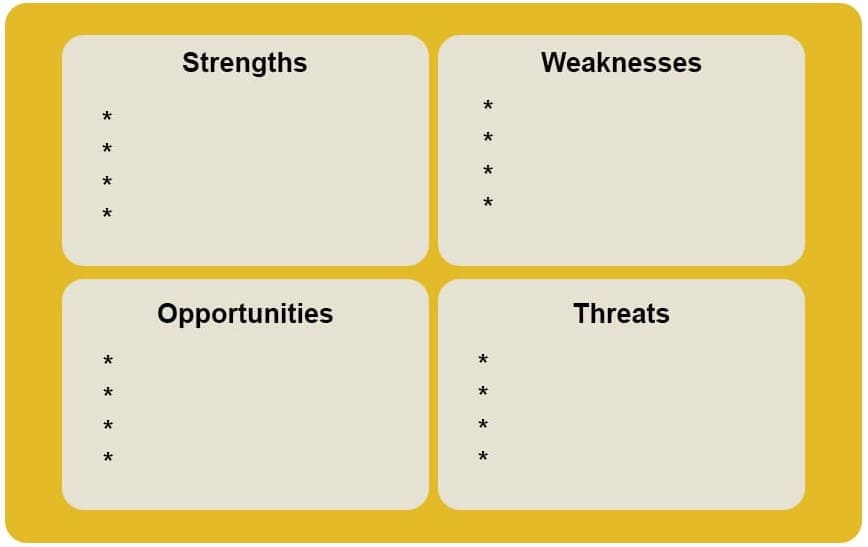Definition: SWOT Analysis is a strategic planning technique used to help an organization identify and analyze its competitive position.
SWOT stands for strengths, weaknesses, opportunities, and threats. This analysis helps organizations find their strength and weakness and identify external threats and opportunities based on the results.
SWOT Analysis
This technique is used in the initial stages of decision-making processes to identify the internal and external factors that are favorable and unfavorable to achieve the strategic objectives of the project.
SWOT analysis has four elements:
- Strengths: Characteristics of a product, person, place, industry, or campaign that gives an organization an advantage over its competitors. Strengths are internal factors.
- Weaknesses: Characteristics of a product, person, place, industry, or campaign that gives an organization a disadvantage over its competitors. Weaknesses are internal factors.
- Opportunities: Opportunities of a product, person, place, industry, campaign, etc., that makes it possible to implement strategies that eventually increase profitability. Opportunities are external factors.
- Threats: Threats might impact the profitability of a business and are considered external factors.
SWOT analysis can help businesses analyze their current status by challenging constraints, delivering new insights, and uncovering blind spots in business performance that can help them develop the right strategy.
Factors in SWOT Analysis
SWOT analysis has two factors:
- Internal
- External
Let’s look in detail at internal and external factors.
Internal Factors
Strengths and Weaknesses are internal factors. For example, a slow website is an internal weakness since an organization can improve the performance of the website.
Examples of internal factors are:
- Financial resources (sources of income and investment opportunities)
- Physical resources (location, facilities, and equipment)
- Human resources (employees, organizational structure, customers, and target audience)
- Current processes (team structure, company culture, company image, existing products and their designs, and a company’s operating efficiency and capacity)
- Patents, copyrights, trademarks, and access to natural resources
External Factors
Opportunities and Threats are external factors. For example, an emerging competitor is considered an external threat because the business has no control over it.
Examples of external factors are:
- Market trends (shift in customer needs, new products trends, technology advancements, customers, and their competitors)
- Economic trends (local, national, and international economic trends)
- Funding (income from other sources such as donations)
- Country-specific Regulations (Political, environmental, economic regulations)
- Demographics
- Relationships with suppliers and partners
Let’s discuss the SWOT elements in detail.
Strengths
Strengths are a business’s strong points. These points show where the organization is better than its competitors. Consider strengths from an internal and a customer perspective.
Analyze the area where the business performance meets and exceeds expectations.
- What advantages does the organization have over competitors?
- What unique resources does an organization have compared to competitors?
- What is a business’s unique selling proposition?
- What positive customer perception does the organization have?
- What low-cost resources do you have compared to your competitors?
Weaknesses
Weaknesses are the areas where businesses struggle to meet expectations and areas where they don’t feel confident . Consider weaknesses from an internal and a customer perspective.
Spend some time thinking about areas that need improvement. Analyze the brand, find reasons for consumers choosing competitors, and identify what services are offered by competitors but not by the organization.
- What does the organization not do well?
- What weaknesses do consumers see in products?
- What factors contribute to a weaker brand image?
Opportunities
Opportunities are the areas that organizations could take advantage of. Consider untapped or underserved markets. Consider opportunities from an external perspective.
Can the business change the product or service to better serve a wider audience? Any weakness that can be turned into a strength should be included as an opportunity.
Consider:
- What external factors can contribute to help fill in market gaps?
- What market trends could the organization capitalize on?
- Can the organization take advantage of any changes in technology?
- Can an organization take advantage of changes in consumers’ lifestyles or social patterns?
Threats
Threats are the potential or upcoming obstacles that a company should be wary of.
An emerging competitor, changes in the market trends, and things that could negatively impact business are the threats. Threats can be known or unknown. To manage known threats, organizations can develop a contingency plan.
Consider:
- What obstacles does the organization face?
- Are there any emerging competitors?
- Is a change in technology threatening the position of your company?
- Does a change in consumer lifestyle and social patterns threaten your company?
- Does the organization have negative press/media coverage?
- Is there any change in regulation that could impact your business?

SWOT Analysis Template
Below is an example of a SWOT analysis template.

When to Perform SWOT Analysis
An organization can perform SWOT analysis in the following cases:
- Planning for any new initiative
- Considering internal changes
- Reviewing the organization’s performance
How to Conduct SWOT Analysis
If all team members are co-located:
- Gather the team in a commonplace
- Set up quadrants on a whiteboard or in a word document
- Start identifying strengths
- Follow suit with weaknesses, opportunities, and threats
- Come up with action items, and identify owners for each of them
If all team members are remotely located:
- Before the meeting, ask individuals to come up with their data points
- Gather the team for a common meeting
- Set up quadrants in a word document or any other predefined template
- Start consolidating strengths and brainstorming on them
- Follow suit with weaknesses, opportunities, and threats
- Come up with action items, and identify owners for each of them
SWOT Analysis Examples
The following is an example of a SWOT analysis for a one-year-old product-based Information Technology startup.
Strengths: Since the product is new, it has the ability to change and adapt quickly.
Weaknesses: Shortage of human resources can cause difficulties when dealing with larger assignments.
Opportunities: Can corner the emerging market because the product is interesting.
Threats: Self-funded and lack of angel investors. The lack of a sales team can cause competitors to seize the opportunities.
If funding is available, the organization can employ a sales team to corner the market opportunities and make the product more successful.
Benefits of SWOT Analysis
The followings are a few benefits of SWOT analysis:
- It is a low cost and simple technique
- Helps in strategic organizational planning
- Builds on organizational strengths and diminishes the effect of weaknesses
- Helps overcome external threats
- Helps identify the core competencies of the organization
- Helps set strategic objectives
- Provides a general overview of business operations
- Provides the organization with competitive standing in the market
- Improves project performance
SWOT Analysis Challenges
Vague
- If the business is vague and data points are invalid, SWOT analysis will not be helpful.
Focusing Only on Weaknesses
- Focusing only on weaknesses without understanding the organization’s strengths is detrimental because businesses don’t know what they are doing well and how they can improve further.
Focusing Only on Strengths
- Focusing only on the strengths without looking at low-performing areas negatively affects the analysis, and the organization may not realize the full benefits of SWOT analysis. Take feedback from customers and peers to improve the low-performing areas.
Being Unrealistic
- Pinning a risky objective is an unrealistic opportunity. For example, let’s say the government plans to ban alcohol, so organizations hope to expand their cool drinks business, assuming people will drink more soft drinks once the ban is in place. However, this is unrealistic.
Making Lists Too Long
- Focusing on large amounts of data is difficult. Instead, focus on a couple of them, or split into multiple teams to work on them. Ensure that the listed ideas are feasible.
Not Thinking Ahead
- There can be thousands of ideas; make sure to focus only on practical ideas. It is important to check the practical feasibility of ideas.
Relying on SWOT Analysis Alone
- A strength for one objective can be a weakness for a different one. SWOT analysis helps businesses improve and find opportunities and risks, but it may be more beneficial if businesses can pair it with other tools. Other tools that can pair well with SWOT analysis include TOWS (Same as SWOT, but in SWOT, the primary focus is on internal factors, whereas TOWS’ primary focus is on external factors), PEST (Political, Economic, Social and Technological Analysis), and SOAR (Strengths, Opportunities, Aspirations, and Results).
Conclusion
A SWOT analysis is a simple and effective tool used during the planning stage when determining the strategic objectives of the company. SWOT analysis helps identify the strengths and weaknesses of an organization, so an organization can identify the business’s opportunities and reduce the impact of weaknesses. SWOT analysis can be applied to any industry to improve performance.
